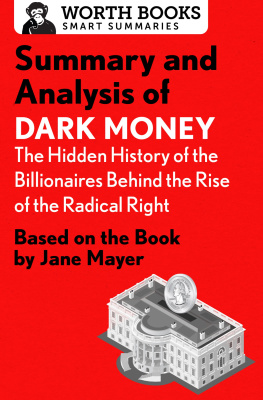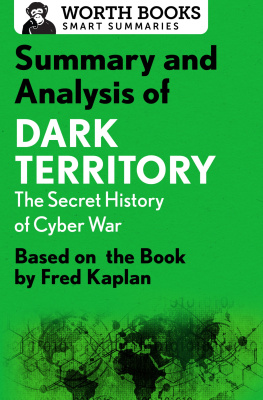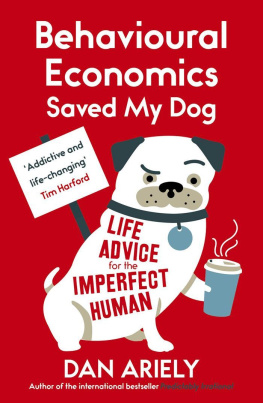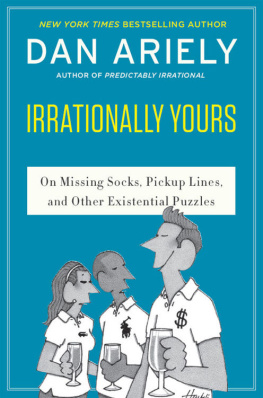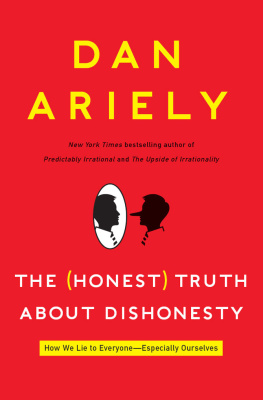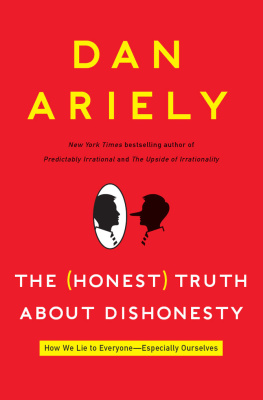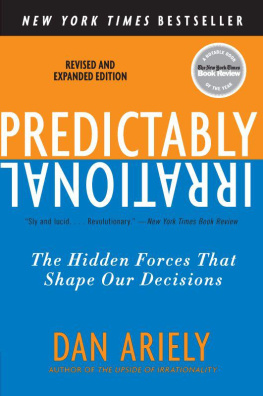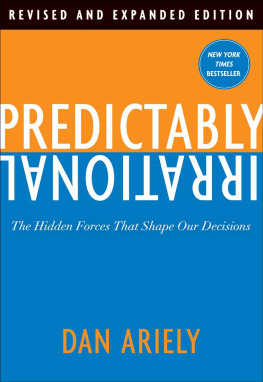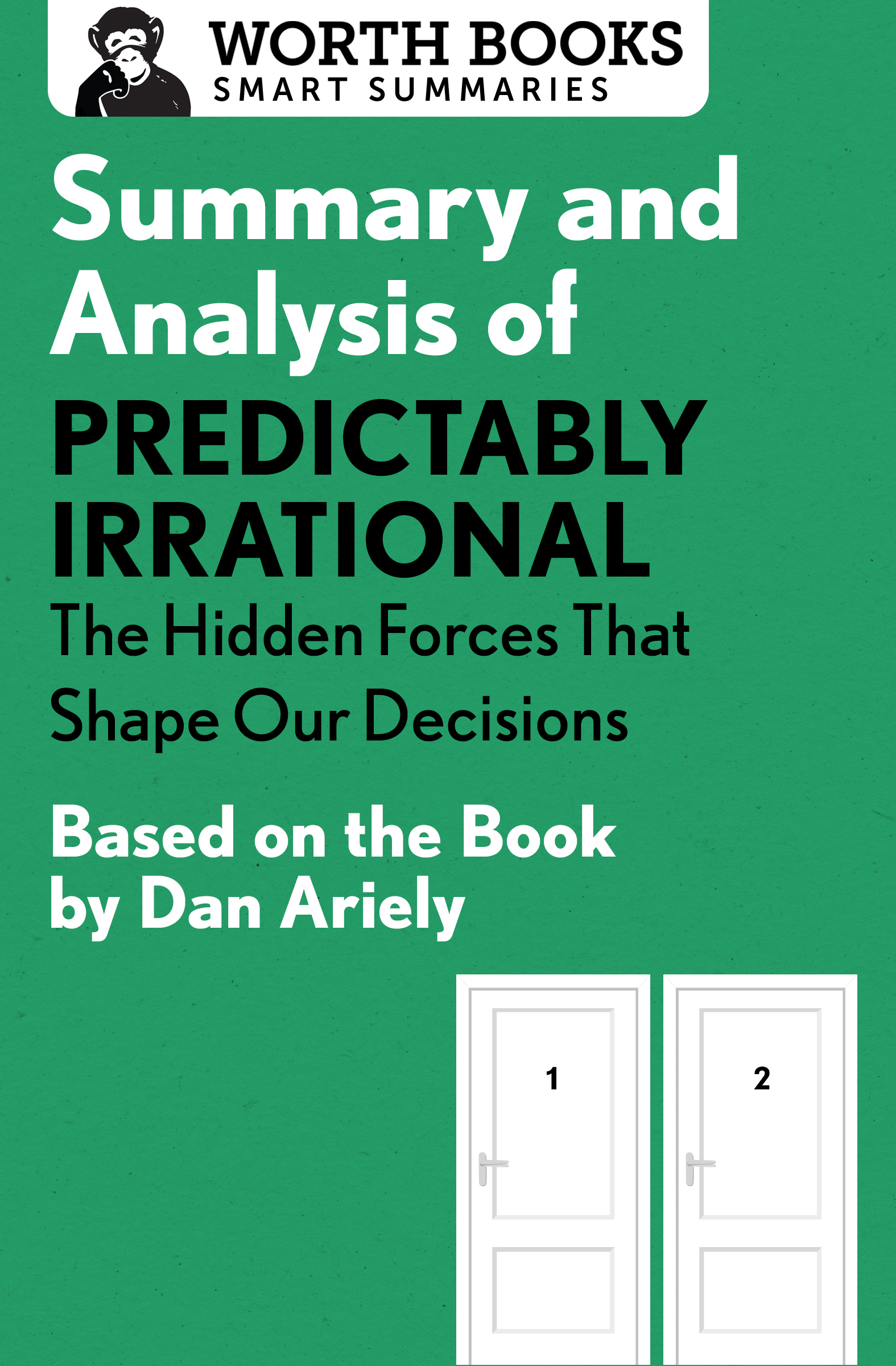Summary and Analysis of
Predictably Irrational
The Hidden Forces That Shape Our Decisions
Based on the Book by Dan Ariely

Contents
Context
Since the 18th century, when Adam Smith theorized that an invisible hand automatically regulated the economy, the ideas of rational economic thought and free markets have dominated the field of economics. But in the past several decades a new field has emergedbehavioral economics, based on the theory that people dont always act rationally, and often make financial decisions based on emotional, psychological, or social factors. Studying these forces can help us understand everything from why individuals struggle with weight loss and saving money to why corporations act immorally and healthcare costs are skyrocketing.
The global recession of 2008 challenged the ideas of rationality and brought behavioral economics to the forefront. Published that same year, Predictably Irrational , Dan Arielys first book, introduced the basic concepts of behavioral economics to the mainstream reader, including those explaining the irresponsible behavior in the housing market leading up to the recession. Filled with the findings from Arielys creative and entertaining studies, the book offers ways of understanding our irrational habits, and explains how we can use that information to make better decisions. The book clearly resonated with readers, becoming a New York Times bestseller.
As a leading researcher in the field, Ariely has since made a name for himself for popularizing behavioral economics and communicating its ideas outside of academia. He has gone on to publish four more books on the topic, and is a regular contributor to publications such as the New York Times , the Wall Street Journal , and Psychology Today .
Overview
While traditional economic theory assumes everyone in the market, given complete knowledge of a situation, makes perfectly rational decisions based on a cost-benefit analysis, behavioral economics acknowledges the ways in which emotions, psychology, and social pressures encourage us to make irrational choices instead. Predictably Irrational provides an in-depth look at the factors influencing our decisions, examining not only how we act irrationally but why, so that we can anticipate similar behaviors in the future and adjust our thinking to make more rational decisions.
In each section of the book Ariely explores a different type of irrational thinking, providing examples from everyday life such as trick-or-treating, dating, or helping a neighbor move a couch to illustrate each concept. He delves into the power of expectations, such as how positive associations with a brand can increase our enjoyment of its product, and why patients taking fake medicine still experience real benefits. Ariely then creates experiments to document his often humorous observations, explains the results, and suggests ways to improve decision-making.
Ariely also introduces technical concepts, such as relative advantage; arbitrary coherence and anchor prices; the psychological pull and hidden cost of free goods; and how social norms influence our financial decision making. He shows how high emotional arousal challenges our ability to make rationaland even moraldecisions, and how the desire for immediate gratification leads to procrastination and limited self-control.
Part of Arielys project is to not only explain the truths that underpin our behavior in the market, but to show how they can be used to further social good. Thus, the later chapters explore dishonesty at both the individual and institutional level, with Ariely explaining why morally upstanding citizens often cheat or steal in small ways, and how corporations and governments rationalize large-scale corruption in the same way. Applying the principles found in Predictably Irrational , Ariely argues, could have enormous social benefits to us all, leading to lives of greater productivity, interconnection, meaning, and even happiness.
A revised and expanded edition of Predictably Irrational was published in 2009, including two extra sections. The first of the bonus material, Reflections and Anecdotes about Some of the Chapters, contains further thoughts or illustrations of the principal ideas discussed in some of the preceding chapters. In this summary and analysis, those stories and notes have been included in the chapter summaries where applicable. The second new chapter, Thoughts about the Subprime Mortgage Crisis and Its Consequences, discusses the economic upheaval of 2008, which occurred after the writing of Predictably Irrational .
Summary
Introduction
When he was a teenager living in Israel, an explosion left more than 70% of Dan Arielys body covered in third-degree burns. For three years, unable to participate in normal, daily life routines while undergoing treatments, he began observing how people around him acted and made decisions. One of the most painful parts of his recovery was the daily bath during which nurses ripped off the bandages covering his burns. Years later, as a student at Tel Aviv University, he decided to study the nature of painspecifically, Was tearing off the bandages as quickly as possible the best strategy for a patients well-being? He found that, contrary to his nurses beliefs, people were better able to endure a lower level of pain over a longer period of time. When he discussed the results with his former nurses, one suggested that they ripped the bandages off quickly because it shortened the time of their own agony watching patients suffer.
Ariely realized that decisionseven those made in a hospital, an environment supposedly governed by rational sciencewere often made for irrational reasons. He wondered in what other situations people made such decisionsand if it would be possible to predict the circumstances under which we might act irrationally.
Need to Know: Behavioral economics is the study of how psychological, emotional, and other forces affect our decision-making.
Chapter 1: The Truth about Relativity
Why Everything Is RelativeEven When It Shouldnt Be
To demonstrate how comparisons and relativity affect decision-making, Ariely conducted an experiment using an offer he saw for subscription options to The Economist magazine. Given three choices ($59 for online-only access, $125 for a print-only subscription, or $125 for both print and online), study participants overwhelmingly chose the third option. However, when he conducted a study offering only the $59 online-only option and the $125 print-and-online choice, the majority opted for the first choice. Without having the middle option (a so-called decoy) that established the value of print-only at $125, people couldnt compare the relative value of online-only versus print and online.
Companies use this strategy to encourage customers to spend more all the time. For example, when the kitchen supply store Williams-Sonoma introduced their first bread machine at the relatively expensive price of $275, it didnt sellbuyers had little knowledge of the bread-machine market, and no basis for comparison. However, when the company offered a second model at a 50% higher price, sales of the $275 model surged. In comparison, the cheaper model appeared to be a good value.
This concept of relative worth has societal implications. In 1993, federal security regulators began to require that companies reveal the pay of their top executives to stop outrageous salaries and benefits. The regulation ended up having the opposite effect. Now that CEOs could see how much their competitors were makingthus learning their relative valuethey demanded to earn as much as their higher-paid peers. Currently, the average CEO makes three times as much as before their salaries were public.




